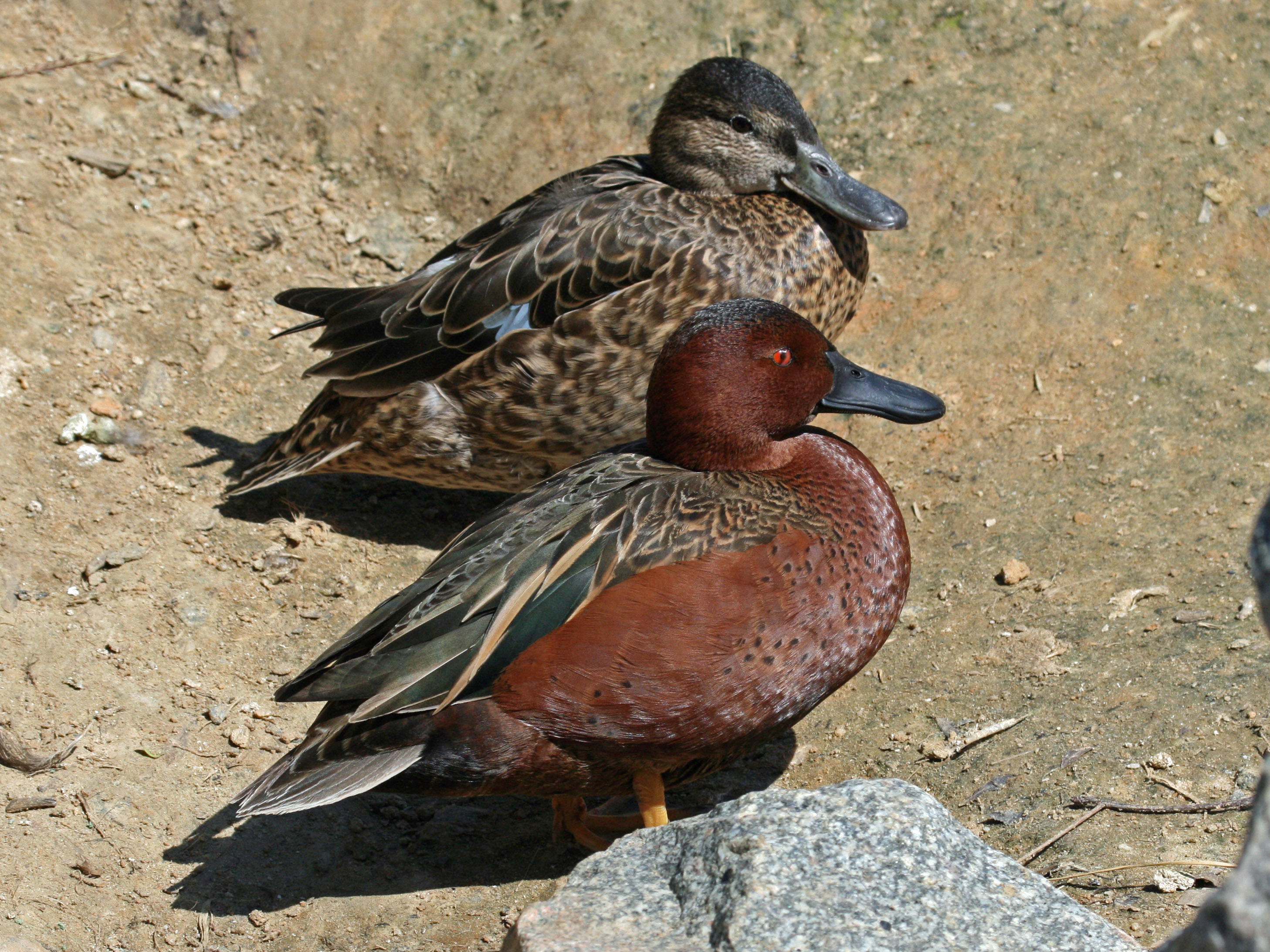
Cinnamon teal(Anas cyanoptera)
Phylum —chordata
Class — aves
Order — anseriformes
Family — anatidae
Genus –anas
Appearance
The adult male has a cinnamon-red head and body with a brown back, a red eye and a dark bill. The adult female has a mottled brown body, a pale brown head, brown eyes and a grey bill.
They are 16 in (41 cm) long, have a 22-inch (560 mm) wingspan, and weigh 14 oz (400 g). They have 2 adult molts per year and a third molt in their first year.
Habitat
Their breeding habitat is marshes and ponds in western United States and extreme southwestern Canada, and are rare visitors to the east coast of the United States. They are migratory and most winter in northern South America and the Caribbean. Some winter in California and southwestern Arizona.
Behavior
Cinnamon teal are usually found in small flocks, comprising pairs of birds. During the spring migration the flocks increase in size, containing up to twenty birds. Migration in the spring occurs during March and April.
Although this birds are basically aquatic animals, they are mobile on land and are able to walk or run around loafing areas on land. They are very agile in flight.
Cinnamon teal preen both on land and in water. They tend to preen more during the middle of the day than the morning or the evening.
Pairs tend to sleep or rest within one meter of one another, and the males often remain alert while the female sleeps. The sleeping sites are water or dry areas near the water, and resting time tends to be midday more than morning or evening. Generally, from the spring arrival to the incubation period the day is spent sleeping and loafing, with time also spent preening, swimming, walking, or flying.
Diet
Generally, cinnamon teal feed in the shallow waters of marshes and lakes. They also dive for food, or get it from the shoreline. Cinnamon teal dive for vascular rooted plants, or they eat arthropods from the bottom-aquatic bed.
From terrestrial surfaces, cinnamon teal eat flowers and fruits of grass-like vegetation.
Reproduction
Mating pair bonds are renewed each season, during the winter. Females attract the males by swimming in front of the desired mate. The reproductive behavior of males includes several behaviors intended to attract unpaired females, such as preen-behind-wing, preen-dorsally, belly-preen, preen-back-behind-wing, repeated calls, turning back of head, and head-dip. If several males are competing for one female, drakes perform short flight displays. Actual copulation occurs on the water surface. The male and female both engage in head bobbing directed toward one another. Next, the female gets into a prone position and the male then gets behind the female and mounts while grasping the neck with his bill. After internal copulation, both the male and female bathe and preen.
The cinnamon teal hen constructs a half-moon shaped nest out of plant stems and dead grass. Young birds are covered in down when they hatch, and leave the nest within 24 hours of hatching. Generally, this is to travel with the hen to a nearby water source. The ducklings are able to feed themselves from the first day that they hatch. However, they remain under the care of the hen until fledging, which occurs after 7 weeks. As they get closer to fledging they range farther from the nest and the hen. Sexual maturity is reached after one year, when a cinnamon teal is able to breed.
In captivity
Lifespan in captivity is up to 30 years.
In summer, teals are kept in outdoor enclosures. The minimum size of the enclosure is 3 square meters.
In winter, they should be transferred to an insulated enclosure with a temperature of at least +5 °C. However, cinnamon tealscan easily live at cold temperatures (up to -7 °C), and in areas where winter temperatures do not fall below -8 °C, they can be kept outdoors all year round. It is desirable to equip the enclosure with additives in the form of branches and perches. In the winter room, you must install a pool with running or frequently replaced water. In areas with mild winters, cinnamon tealscan be kept in outdoor enclosures.
In this case, all winter it is necessary to maintain a sufficient mirror of the reservoir for birds, not covered with ice. This is achieved in various ways, one of which may be the use of an air compressor. Long hoses from the compressor that pumps air are lowered to the bottom of the reservoir, and air bubbles, rising up, carry warmer water. With constant mixing of warm water from the lower layers of the reservoir with colder water from the surface, the possibility of ice formation is eliminated even in the most severe frosts.
As a winter bedding for waterfowl, you can use soft hay, which is laid out in places where birds rest.
The diet includes grain feed-corn, wheat, barley, millet, oatmeal, wheat bran, grass, meat and fish meal, chalk, small shell, gammarus. In the warm season, it is good to give various greens - cut dandelion leaves, lettuce, plantain, duckweed. Good food for ducks - wet mixture of grated carrots, bran, various cereals. During the reproductive period and during molting, they are mixed with wet food or given separately: fish and minced meat.During working out a diet it should be calculated that the amount of raw protein does not exceed 18-19%.
Cinnamon tealsare friendly to other birds, so they can be kept on the same pond with other ducks.
Artificial shelters for nests are installed in the paddock. Ducks independently incubate, breed and raise young ducklings.
 Russian
Russian
 English
English
























